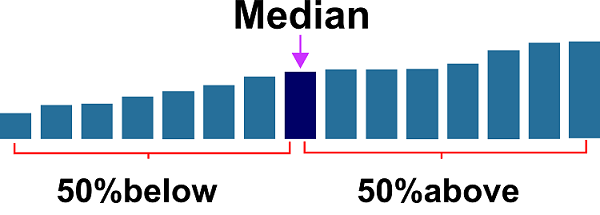Advantages and Disadvantages of Median

The median is a statistical measure used to describe the central tendency of a dataset. It represents the middle value when the data set is ordered from least to greatest. Here are the advantages and disadvantages of using the median:
Advantages of Median:
Resilience to Outliers: The median is less sensitive to extreme values or outliers in a dataset compared to the mean. Outliers can disproportionately influence the mean, but they have minimal impact on the median.
Applicability to Ordinal Data: The median is particularly useful when dealing with ordinal data, where the order of values matters, but the exact differences between values may not be meaningful. It gives a representative value that corresponds to the middle of the ordered data.
Robustness: The median is a robust measure of central tendency because it is not influenced by extreme values. It provides a stable estimate even in the presence of skewed distributions.
Ease of Computation: Calculating the median is straightforward, especially when dealing with a small dataset or when the dataset is already ordered. It involves finding the middle value or the average of the two middle values.
Applicability to Skewed Distributions: The median is a suitable measure of central tendency for skewed distributions, where the mean might be influenced by the skewness.
Disadvantages of Median:
Loss of Information: Unlike the mean, which takes into account all values in a dataset, the median only considers the middle value(s). This can result in a loss of information, especially in datasets where the overall distribution shape is important.
Limited Applicability to Interval/Ratio Data: While the median is suitable for ordinal data, it may not be the best choice for datasets with interval or ratio data, where the differences between values are meaningful. The mean is often preferred in such cases.
Complexity with Grouped Data: Calculating the median for grouped data (data divided into intervals or classes) can be more complex and less precise compared to calculating the mean.
Not Always Unique: In cases where the dataset has an even number of values, the median may not be a unique value but a range. This can be a limitation when a single representative value is desired.
Not Sensitive to Magnitude: The median does not take into account the magnitude of differences between values; it only considers their order. This can be a disadvantage when the magnitude of values is relevant, as in the case of the mean.
In summary, the choice between using the median or other measures of central tendency depends on the nature of the data and the specific goals of the analysis. The median is a valuable statistic, especially in situations where robustness to outliers is important. However, researchers should carefully consider the characteristics of the dataset before deciding on the appropriate measure of central tendency.
Thank you.